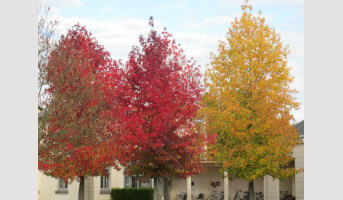Interview with Céline Masclaux-Daubresse for the daily newspaper Le Monde
Céline Masclaux-Daubresse, INRAE Senior Scientist, co-leader of the "Senescence, Autophagy, Nutrient Recycling and Nitrogen Use Efficiency" SATURNE team and Deputy head of the INRAE "Plant biology and breeding" BAP division, is a specialist in senescence and autophagy. She was interviewed on this topic by Florence Rosier, Journalist at Le Monde, Planète Service, Sciences, agricultural engineer and doctor-engineer.
Discover the Column
"The Hidden Life of Plants." Before falling, leaves are emptied of much of their contents, which are exported and recovered by the bark, trunk, and roots. Stored throughout winter, these resources are used in spring to nourish new leaves.
November. “Behold the sapless leaves / That fall upon the grass, / Behold the rising wind / That moans within the vale.” Alphonse de Lamartine (1790–1869) was not wrong: by the force of nature (and gusts of wind), the fallen leaves are indeed sapless. Yet, just before falling, the leaves remain connected to the tree’s vital flow of sap, even as their aging process draws to an end.
“In animals, senescence has a negative connotation, but in plants, it’s a survival mechanism and an adaptation to environmental stress,” explains Céline Masclaux-Daubresse. Here, the key word is: recycling. In autumn, elements stored in the leaves during summer are recycled and exported via the sap flowing from the treetops down to the roots. This process enables deciduous trees to recover a large portion of nutrients that would otherwise be lost when leaves fall. “Especially minerals that plants cannot easily obtain, such as nitrogen, phosphorus, sulfur, or iron,” adds the plant physiologist... More
In connection with the research developed at the Institute Jean-Pierre Bourgin for Plant Sciences.
Back

More about Céline Masclaux-Daubresse, see the IJPB news of 20/12/23